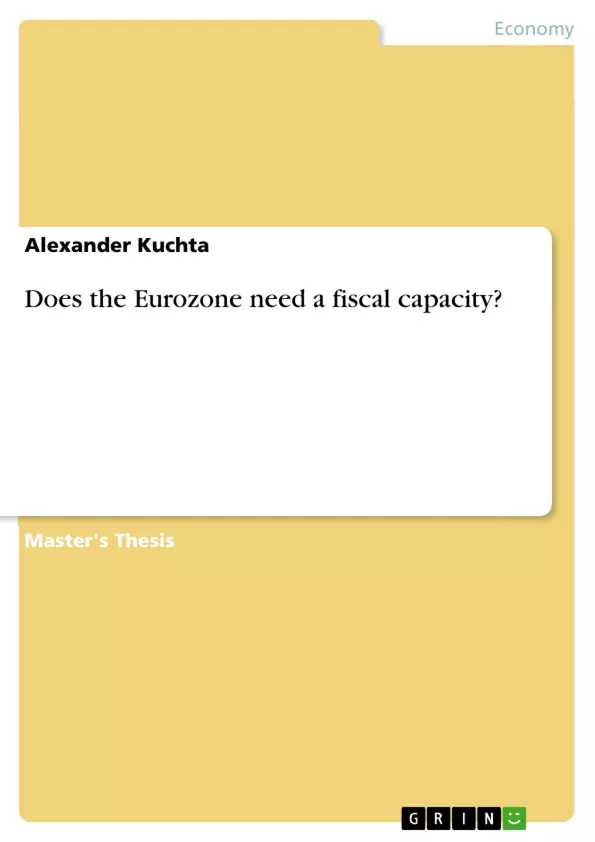The European Monetary and Economic Union (EMU) is often described as a house without a roof. It is nice to be in it when the sun is shining but a horrible place to be when it starts to rain. A roof in this case alludes to the fact that the Euro is a currency without a state. MacDougall (1977) has addressed this issue in the 1970’s where he highlighted the necessity of a fiscal capacity. He proposed that before a common currency could be introduced, some form of federal budget should be established in order to help aligning the member states more closely to each other. During the first years of the Euro it seemed as if these opinions were wrong. The euro was a stable currency that even threatened the supremacy of the dollar. However, these days are long gone. The financial crisis and the subsequent sovereign debt crisis have revealed that the inherent problems of the euro were covered by immense flows of capital from north to south. When these flows abated the Eurozone was left in a state of large disequilibria without any instruments to cope. As readjustment takes longer than expected, the political, economic and social costs have since then increased strongly (see exemplarily Sinn (2012)).
This master thesis picks up on this topic and tackles the question whether or not the Eurozone needs a common budget or transfers mechanism in order to cope with the challenges of a common currency.
In order to do so Chapter 2 will explore the optimal currency theory and try to determine how fiscal transfers can help to cope with idiosyncratic shocks. Subsequently, Chapter 3 analyses the roots of the large disequilibria in the EMU. An analysis of the degree of business cycle convergence and inflation differentials is conducted. Chapter 4.1. investigates the role of automatic stabilisers as a shock absorption instrument and tries to determine how much insurance it can provide for the regions in existing federations. In Chapter 4.2. the efficacy of the enacted changes in the EMU financial, fiscal and eco-nomic framework to cope with the existing weaknesses of the EMU structure is determined. , Chapters 4.3, 4.4 and 4.5 are assessing the potential impact of a European tax-benefit systems and European economic agency, transfer mechanism based on a macroeconomic indicator and a European basic unemployment insurance in terms of business cycle conver-gence, countercyclical properties and their potential problems.
Inhaltsverzeichnis (Table of Contents)
- 1. Introduction
- 2. The optimal currency area theory
- 2.1 Automatic adjustment under a flexible exchange rate regime
- 2.2 Wage flexibility
- 2.3 High factor mobility
- 2.4 Financial market integration
- 2.5 The degree of economic openness
- 2.6 Similarities in institutions
- 2.7 Diversification in production and consumption
- 2.8 Similarities in inflation rates and preferences
- 2.9 Political integration and political feasibility
- 2.10 Fiscal transfers
- 3. Selected issues on the Eurozone and optimal currency area criteria
- 3.1 Business cycle convergence
- 3.2 Inflation differentials
- 3.3 Current account imbalances
- 4. Rationale and options for a fiscal capacity in the Eurozone
- 4.1 Packs, compacts and mechanisms – steps taken so far
- 4.1.1 Effect on business cycle convergence
- 4.1.2 Effect of efficacy on inflation differentials
- 4.1.3 Effect of efficacy on current account deficits
- 4.1.4 The Banking Union and its contribution to business cycle convergence
- 4.2 Automatic stabilisers
- 4.2.1 Estimation utilising macro models
- 4.2.2 Estimation utilising micro models
- 4.2.3 The case for an EMU-wide automatic stabiliser
- 4.3 European Tax-benefits system and a European economic agency
- 4.4 Fiscal transfers based on macroeconomic variable
- 4.5 A EMU -wide unemployment insurance
- 5. Conclusion and critical assessment
Zielsetzung und Themenschwerpunkte (Objectives and Key Themes)
This master thesis investigates the necessity of a common budget or transfers mechanism for the Eurozone to effectively manage the challenges associated with a shared currency. It examines whether the Eurozone requires a fiscal capacity to address these issues.
- The optimal currency area theory and its relevance to the Eurozone.
- An analysis of the Eurozone's economic imbalances, including business cycle convergence, inflation differentials, and current account deficits.
- The effectiveness of existing fiscal mechanisms in the Eurozone.
- Potential options for establishing a fiscal capacity, such as automatic stabilisers, European tax-benefits systems, and a Eurozone-wide unemployment insurance.
- The potential benefits and challenges of implementing a fiscal capacity in the Eurozone.
Zusammenfassung der Kapitel (Chapter Summaries)
Chapter 2 explores the optimal currency area theory, examining the conditions necessary for a successful monetary union. It investigates how fiscal transfers can contribute to managing idiosyncratic shocks within the Eurozone.
Chapter 3 analyzes the economic imbalances within the Eurozone, focusing on business cycle convergence, inflation differentials, and current account deficits. It compares these imbalances to those of the United States, a long-standing and comparable monetary union.
Chapter 4 delves into the rationale and options for establishing a fiscal capacity within the Eurozone. It examines the effectiveness of existing fiscal mechanisms and explores potential avenues for creating a more robust system, including automatic stabilisers, European tax-benefits systems, and a Eurozone-wide unemployment insurance.
Schlüsselwörter (Keywords)
This master thesis focuses on the Eurozone, fiscal capacity, optimal currency area theory, business cycle convergence, inflation differentials, current account imbalances, automatic stabilisers, European tax-benefits systems, and Eurozone-wide unemployment insurance. It examines the effectiveness of various fiscal mechanisms and potential options for establishing a more robust system to address economic challenges within the Eurozone.
- Citar trabajo
- MSc Alexander Kuchta (Autor), 2015, Does the Eurozone need a fiscal capacity?, Múnich, GRIN Verlag, https://www.grin.com/document/311146



